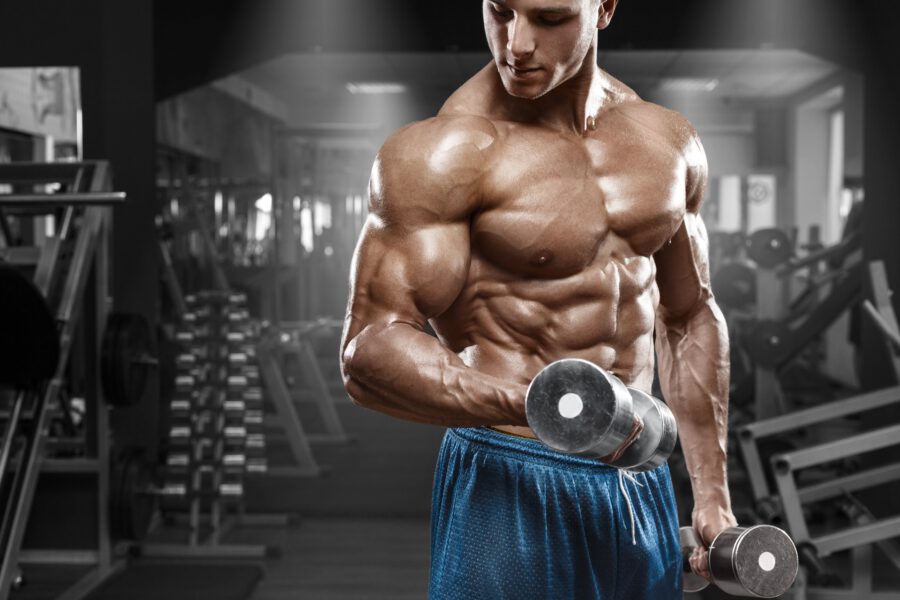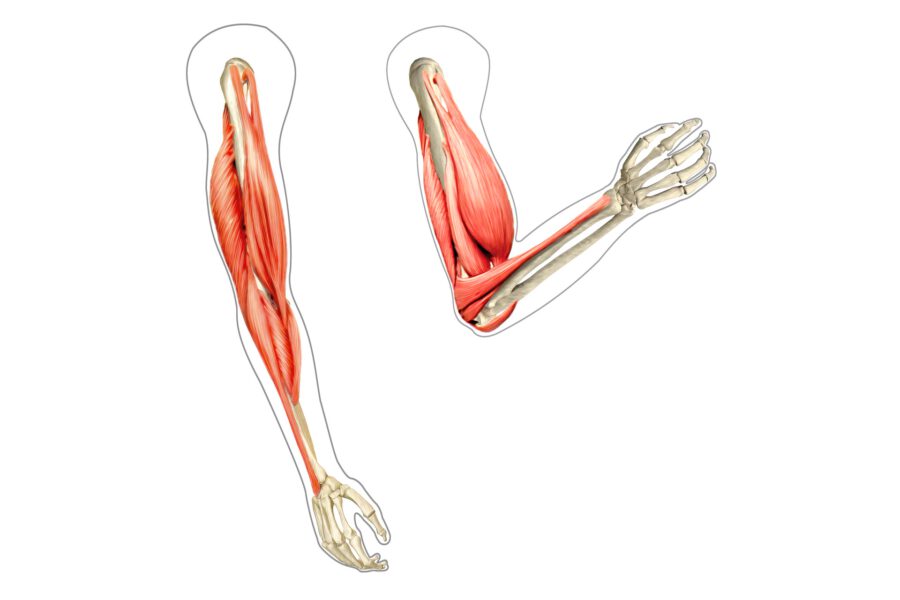The Ultimate Bicep Workout for Size & Strength
The biceps have been, are, and always will be the show muscle of the body. That’s why they are the most trained body part; every guy wants loaded guns. Unfortunately, most guys fail to achieve them. In their enthusiasm, a lot of people overwork their biceps, preventing them from fully recovering to grow. Others pile so much weight on the barbell curl that they completely butcher their form, working their back more than their arms. In this article, I’ll lay out a simple but extremely effective biceps workout to achieve the maximum size and strength gains.
There are two distinct parts, or heads, to the biceps brachii muscle. They are known as the long head and the short head. Both heads have their origin on the scapular but at slightly different points, with the short head originating higher than the long head. Both the long and short head insert into a single tendon which crosses the elbow joint and connects to the radius, or forearm bone.
The function of the biceps is to extend the elbow. It also plays a minor role in shoulder flexion, as when the arm rises in front of the body.
From this brief overview of the anatomy of the biceps, we learn an important point. Whenever the biceps does its job of bending the elbow, both the long head and the short head are involved. Remember, too, that the elbow is a hinge joint; it can only bend one way. What this means in practical gym terms is that it is impossible to isolate either of the bicep heads. In other words, you can’t do an exercise to focus on just the short head or the long head in order to change the shape of the muscle. Every exercise you do is working the long and short head equally.
As with every muscle in the body, the best exercises for the biceps will be ones that move the muscle from its insertion to its origin point as naturally as possible. That means bending the arm from a fully extended position to one where the hands end up at shoulder level. This should be done with the elbow at the side of the body. Any variation from this natural position moves away from the body’s ideal positioning for biceps flexion.
The exercise that best matches this ideal movement pattern is the standing curl. This exercise also follows the ideal strength curve for the biceps, with the resistance being heavier at the beginning of the movement and lighter at the end of the rep.
You will see guys in the gym doing curls in every imaginable way, with the main difference being the angle of the humerus (upper arm bone) in relation to the torso. You‘ll see them doing cable curls that start with their arms out horizontally in line with the shoulders, with the arms behind the torso, and with them in front on a preacher bench. Yet, all of these exercises involve the exact same biceps flexion. The only difference is the amount of stretch that is placed on the biceps in the start position.
This overstretching of the biceps in the start position of the exercise does not produce any benefit. In fact, it makes the muscle more prone to injury. Doing a curl with the arms above the shoulder level in the start position may also activate reciprocal innervation, where opposing muscle groups shut off. That’s because the triceps will become activated.
This exercise follows the natural function of the biceps with the elbow in at the side of the body. Performing the curl with dumbbells rather than a barbell allows you to work each of the biceps unilaterally and prevents the stronger side from taking over to produce uneven form and development. Performing the exercise alternately rather than curling the dumbbells together has also been shown to allow for stronger muscle contraction.
Doing the alternate curl with a cable pulley machine allows you to stand slightly forward of the resistance, which places resistance on the biceps at the very start of the movement. There is no initial resistance when you are doing the curl with dumbbells. You are also able to achieve a stronger contraction at the end of the curl when using cables.
The seated version of the alternate dumbbell curl is stricter because it eliminates the ability to bring the momentum of your lower body into the movement. The seated alternate curl also provides an ideal resistance curve for the biceps.
The biceps brachii is a relatively small muscle group. It is also a muscle that comes into play when working other body parts, including the lats and the traps. It is important, therefore, that you don’t overtrain this muscle group. I recommend doing 8 sets for this muscle group every 4-5 days.
Your rep range should be high enough to promote sarcoplasmic hypertrophy and to fully activate your slow-twitch muscle fibers. Doing some high rep sets will also engorge the muscle with blood to promote the pump effect. It should also go low enough to promote myofibrillar muscle growth and hit your fast-twitch fibers.
You should use the three exercises mentioned above – standing alternate dumbbell curl, standing alternate cable curl, and seated alternate dumbbell curl – to build your biceps workout routine.
One way to structure your workouts is to work through the exercises over three workouts on a continual rotation, doing just one exercise per workout. Do 8 sets for each workout as follows:
- Set One – 30 reps
- Set Two – 20 reps
- Set Three – 15 reps
- Set Four – 10 reps
- Set Five – 10 reps
- Set Six – 8 reps
- Set Seven – 8 reps
- Set Eight – 6 reps
Another option is to use two exercises per workout doing four sets of each one, with the following rep scheme:
- Set One – 20 reps
- Set Two – 10 reps
- Set Three – 8 reps
- Set Four – 6 reps
Here’s a workout you should try:
Training the biceps shouldn’t be complicated. You don’t need to be doing fancy exercises from weird angles and you cannot do movements to make the biceps peak higher or the muscle belly wider. All you can do is flex the elbow by shortening and lengthening the muscle. The most natural, and therefore, the best, exercises to do are the three versions of the alternate curl discussed above. Focus on those three moves, constantly working to add resistance while still using impeccable form, and those guns will be locked and loaded.

